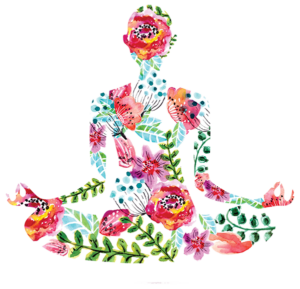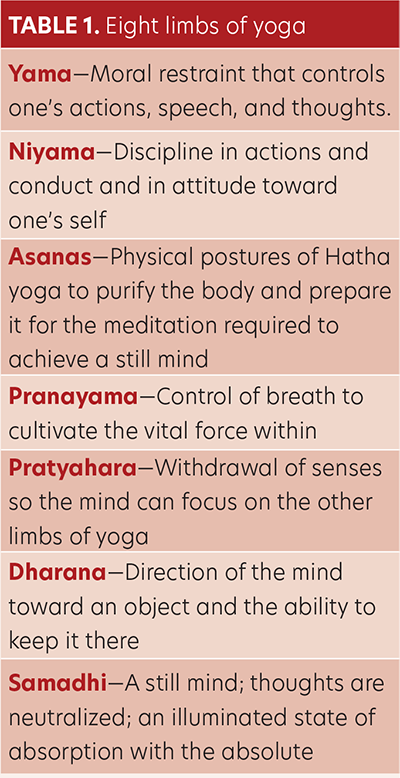
Here we will focus on defining the six main types of Asanas yoga.
There are six systems of Indian philosophy: Nyaya, Vaisheshika, Samkhya, Yoga, Mimamsa, Vendanta. The Yoga system of philosophy dates back 2,500 years with the publication of the Hindu classic, Yoga-sutras, which is credited to an Indian philosopher named Patanjali, who lived during the second century BCE. Many experts, however, believe the writing of the Yoga-sutras actually spanned several centuries (2nd century BCE to 5th century CE) and that the name “Patanjali” was used by all of the contributing authors over the centuries.1,2
 Yoga, as defined by Patanjali, is chitta-vrtti-nirohdah, or the cessation of the turnings of the mind. The word yoga is derived from the Sanskrit word yuj, which is thought to mean “to unite, to join, or to connect.”3 Very simply put, the goal of yoga is to still one’s thoughts through the practice of yoga so that a harmonious and balanced state of mind can be achieved. Arguably, there are eight limbs of yoga—Yama, Niyama, Asanas, Pranayama, Pratyahara, Dharana, Dhyana, and Samadhi (see Table 1 for definitions of each limb).
Yoga, as defined by Patanjali, is chitta-vrtti-nirohdah, or the cessation of the turnings of the mind. The word yoga is derived from the Sanskrit word yuj, which is thought to mean “to unite, to join, or to connect.”3 Very simply put, the goal of yoga is to still one’s thoughts through the practice of yoga so that a harmonious and balanced state of mind can be achieved. Arguably, there are eight limbs of yoga—Yama, Niyama, Asanas, Pranayama, Pratyahara, Dharana, Dhyana, and Samadhi (see Table 1 for definitions of each limb).
Here in the West, when most of us think of yoga, we think of it in the context of the Asanas limb, which is the physical practice of yoga. There are (arguably) six main types of Asanas yoga practice, each of which is intended to prepare (purify) the mind and body for the meditation needed to achieve a harmonious state of stillness and bliss—Hatha, Vinyasa, Kundalini, Ashtanga, Iyengar, and Bikram.4 Each type represents a specific interpretation of the Yoga system and Asanas limb, and within each type, there are several styles of practice based on interpretations made by individual instructors. Here we will focus on defining the six main types of Asanas yoga.
HATHA YOGA
Hatha yoga is one of the most common forms of physical yoga practiced in the West. Here in the US, Hatha yoga is more or less an umbrella term for the practice of physical yoga postures.4 It covers all the traditional aspects of yoga, including body awareness, breathing, and meditation. Hatha yoga classes typically teach a set of basic yoga postures and breathing techniques that are practiced slowly and methodically.5 Each pose is static, meaning it is held for a specific number of breaths with no movement or transition into another pose. These classes are ideal for beginners and can increase strength, balance, and flexibility and improve posture.
VINYASA YOGA
Vinyasa yoga refers to practicing a sequence of yoga poses in a fast-paced, fluid manner using active breathing techniques to transition from one pose to the next.6–8 The Sanskrit meaning of Vinyasa is “to place (nyasa) in a meaningful way (vi).”9 Like Hatha yoga, Vinyasa yoga is one of the most commonly practiced forms of yoga in the US. Vinyasa yoga is often practiced in a heated room, with temperatures set between 85 and 95 degrees Fahrenheit, though this is not always the case. This form of yoga increases the heart rate and is generally considered a moderate-intensity aerobic exercise.6–8 Vinyasa yoga classes are best suited for those who are familiar with yoga poses and have a good level of fitness.
KUNDALINI YOGA
Kundalini yoga involves chanting or singing, breathing exercises, hand positions, and postures that, when performed together, form kriyas.10 An example of a Kundalini kriya for meditation with which many of us are familiar would be sitting cross-legged on the floor (Lotus position) with arms gently resting on the knees, palms up, fingers extended, with thumbs and forefingers forming circles, while chanting or singing a sound or word with each exhale of breath (e.g., “ohmmmm”). While its origins are unclear, a Pakistani yogi named Bhajan is credited with bringing this form of yoga to the West in the 1960s.11 The word Kundalini is derived from the Sanskrit word kunda, which means coiling like a snake.11 According to Kundalini philosophy, this coiled energy sits at the base of the spine, like a sleeping snake, and practicing Kundalini yoga awakens or activates this energy, which will then travel up the spine and contribute to one’s spiritual wellness.10,11 Practitioners of Kundalini yoga often wear white clothing, in accord with the teachings of Bhajan, who stated that wearing white allows one to “reflect what is outside and go within yourself.”10 Kundalini yoga can be adapted to suit any level of fitness.
ASHTANGA YOGA
Ashtanga yoga is similar to Vinyasa yoga in that it involves practicing a sequence of yoga poses in a fast-paced, fluid manner using breathing to transition from pose to pose; however, while the sequence of poses and the amount of time each pose is held in Vinyasa yoga classes may vary from studio to studio and even instructor to instructor, Ashtanga yoga involves a very specific sequence of poses held for a specific number of breaths and is always practiced in the same manner, regardless of what studio or instructor is teaching the class. Other unique characteristics of Ashtanga yoga include 1) Temperature—Ashtanga yoga is practiced in rooms at or below 80 degrees Fahrenheit; 2) No ambient sounds—no music or other ambient sounds are played during an Ashtanga class; and 3) Length of classes—Ashtanga classes are either 90 minutes or two hours long (vs. the typical 60–75 minutes in a Vinyasa class).12 Ashtanga yoga is considered difficult; experience with yoga poses and a good fitness level are required to practice it.
IYENGAR YOGA
Iyengar yoga was developed by B.K.S. Iyengar, an Indian yoga teacher (1918–2014). Iyengar yoga focuses on three key aspects—alignment, sequencing, and timing—and encourages the use of props, such as wooden blocks, chairs, belts, or blankets, to assist students in achieving proper alignment and form, regardless of fitness level or ability.13 Like Ashtanga yoga, Iyengar yoga follows a specific sequence of poses, and, similar to Hatha yoga, practitioners of Iyengar yoga hold each pose for a set amount of time (breaths) with no movement or transition into another pose.13 Because the poses are held longer, without the fluid movements in between each pose, Iyengar yoga is not considered an aerobic activity. Its main benefits include strength building and improving posture, balance, and flexibility.14 Iyengar yoga is well-suited for beginners and advanced practitioners alike.
BIKRAM YOGA
Bikram yoga was developed by yoga instructor Bikram Choudhury in the 1970s.15 Similar to Ashtanga and Iyengar yogas, Bikram yoga involves a specific sequence of yoga poses, In Bikram yoga, this sequence comprises 26 poses that are repeated over a 90-minute class. What really sets Bikram yoga apart from the other yoga styles is the temperature of the room. In Bikram yoga, the temperature of the room is specifically set to 105 degrees Fahrenheit. The hot temperature is thought to improve blood flow and flexibility and help the body “detoxify” through sweating, though there is no scientific evidence to back these claims.15
Bikram yoga is best suited for those in good physical condition who have yoga experience and can tolerate the extreme heat.
EDITOR’S NOTE
The Yoga system of philosophy is complex, and there appears to be a lack of consistency in the literature when it comes to defining and describing its many components. Here, we attempted to describe the most common (well-known) types of yoga in Western culture as accurately as possible, based on what we consider well-respected sources. However, the reader should note that the wide variability in how yoga and its practices are defined and described in published literature make it impossible for us to say with confidence that the information we present here is wholly accurate…but we did our best.
SOURCES
1. Editors of Encyclopedia Britannica. Yoga philosophy. Encyclopedia Britannica website. https://www.britannica.com/topic/Yoga-philosophy. Accessed 3 May 2022.
2. Editors of Encyclopedia Britannica. Patanjali: Hindu author, mystic, and philosopher. Encyclopedia Britannica website. https://www.britannica.com/biography/Patanjali. Accessed 3 May 2022.
3. Brown C. What is Yoga? In: The Yoga Bible: The Definitive Guide to Yoga Postures. Cincinnati, OH: Walking Stick Press; 2003:8.
4. Yoga Journal website. Hatha yoga. https://www.yogajournal.com/yoga-101/types-of-yoga/hatha/#:~:text=Hatha%20simply%20refers%20to%20the,)%2C%20the%20yoga%20of%20balance. Accessed 3 May 2022.
5. Brown C. Finding your yoga. In: The Yoga Bible: The Definitive Guide to Yoga Postures. Cincinnati, OH: Walking Stick Press; 2003:380.
6. Ward SS, McCluney N, Bosch PR. Heart rate response to Vinyasa yoga in healthy adults. J Yoga Phys Ther. 2013;3:3.
7. Carroll J, Blansit A, Otto RM, Wygand JW. The metabolic requirements of Vinyasa yoga. Med Sci Sports Exercise. 2003;35(5): S155.
8. Tsopanidou A, Theodorakou K, Zacharogiannis E. Heart rate response during a vinyasa yoga session. Sci Gymnast J. 2018;10(1):99–110.
9. Rea S. Consciousness in motion: Vinyasa. 13 Nov 2012. https://www.yogajournal.com/yoga-101/types-of-yoga/vinyasa-yoga/consciousness-in-motion/. Accessed 23 May 2022.
10. Nunez K. What is Kundalini yoga and what are its benefits? 16 Jul 2020. Healthline website. https://www.healthline.com/health/kundalini-yoga. Accessed 23 May 2022.
11. Keutzer K. Kundalini yogas FAQ. May 1996. https://people.eecs.berkeley.edu/~keutzer/kundalini/kundalini-yoga.html#1a. Accessed 23 May 2022.
12. Manfredi A. Ashtanga vs Vinyasa, Parts 1 and 2. 12 Mar 2014. https://www.amandamanfredi.com/amanda-manfredi-yoga-and-photography-1/2013/11/13/ashtanga-vs-vinyasa-part-2. Accessed 23 May 2022.
13. Tomlinson K. What is Iyengar yoga? Ekhart Yoga website. https://www.ekhartyoga.com/articles/practice/what-is-iyengar-yoga. Accessed 23 May 2022.
14. Iyengar Yoga Institute of San Francisco website. What is Iyengar yoga? https://iyisf.org/what-is-iyengar-yoga/. Accessed 23 May 2022.
15. Ghose T. What is Bikram yoga? 18 Jul 2014. Live Science website. https://www.livescience.com/42322-bikram-yoga.html. Accessed 23 May 2022.





